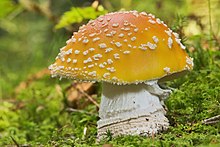Agaricomycetes
| Agaricomycetes | |
|---|---|

| |
| Amanita muscaria (Agaricales) | |
| Scientific classification | |
| Domain: | Eukaryota |
| Kingdom: | Fungi |
| Division: | Basidiomycota |
| Subdivision: | Agaricomycotina |
| Class: | Agaricomycetes |
| Subclasses/Orders | |
|
Agaricomycetidae incertae sedis (no subclass)
| |
Agaricomycetes is a class of fungi. Agaricomycetes include 17 orders, 100 families, 1147 genera, and 20951 species.
All members of this class produce basidiocarps and these range in size from tiny cups a few millimeters across to a giant polypore (Fomitiporia ellipsoidea) greater than several meters across and weighing up to 500 kilograms (1,100 lb).[1]
The group also includes what are arguably the largest and oldest individual organisms on earth: the mycelium of Armillaria gallica have been estimated to extend over 150,000 square metres (37 acres) with a mass of 10,000 kg (22,000 lb) and an age of 1,500 years.[2]
Nearly all species in the class are terrestrial (although a few are aquatic). They mostly function as decayers, especially of wood. However, some species are pathogenic or parasitic, and yet others are symbiotic. These include the important ectomycorrhizal symbionts of forest trees.
References[change | change source]
- ↑ Kirk PM, Cannon PF, Minter DW, Stalpers JA (2008). Dictionary of the Fungi (10th ed.). Wallingford, UK: CAB International. pp. 12–13. ISBN 978-0-85199-826-8.
- ↑ Sjökvist E, Pfeil BE, Larsson E, Larsson K-H (2014). "Stereopsidales – a new order of mushroom-forming fungi". PLOS ONE. 9 (8): e106204. Bibcode:2014PLoSO...995227S. doi:10.1371/journal.pone.0095227. PMC 4002437. PMID 24777067. open access
